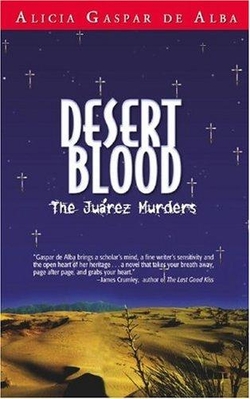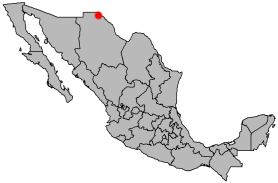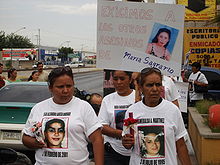
Ciudad Juárez, commonly referred to as just Juárez, is the most populous city in the Mexican state of Chihuahua. It was known until 1888 as El Paso del Norte. It is the seat of the Juárez Municipality with an estimated population of 2.5 million people. Juárez lies on the Rio Grande river, south of El Paso, Texas, United States. Together with the surrounding areas, the cities form El Paso–Juárez, the second largest binational metropolitan area on the Mexico–U.S. border, with a combined population of over 3.4 million people.

A maquiladora, or maquila, is a word that refers to factories that are largely duty free and tariff-free. These factories take raw materials and assemble, manufacture, or process them and export the finished product. These factories and systems are present throughout Latin America, including Mexico, Paraguay, Nicaragua, and El Salvador. Maquiladoras date back to 1964, when the Mexican government introduced the Programa de Industrialización Fronteriza. Specific programs and laws have made Mexico's maquila industry grow rapidly.
Abdul Latif Sharif, first name also spelled Abdel, was an Egyptian-born Mexican chemist and chief suspect in the Juárez killings, a decade-long murder spree that began in the Mexican city of Ciudad Juárez in the early 1990s.

Femicide or feminicide is a term for the murdering of females, often because of their gender. In 1976, the feminist author Diana E. H. Russell first implicitly defined the term as a hate killing of females by males but then went on to redefine it as "the killing of females by males because they are female" in later years. Femicide can be perpetrated by either sex but is more often committed by men. This is most likely due to unequal power between men and women as well as harmful gender roles, stereotypes, or social norms.
Nuestras Hijas de Regreso a Casa A.C. is a non-profit organization composed of mothers, family members, and friends of victims of the female homicides in Ciudad Juárez. The mothers claim that their cases have gone unsolved in some cases for over 12 years. Their hope is to get the murderers of their daughters arrested and hopefully convicted.
Gendercide is the systematic killing of members of a specific gender. The term is related to the general concepts of assault and murder against victims due to their gender, with violence against men and women being problems dealt with by human rights efforts. Gendercide shares similarities with the term 'genocide' in inflicting mass murders; however, gendercide targets solely one gender, being men or women. Politico-military frameworks have historically inflicted militant-governed divisions between femicide and androcide; gender-selective policies increase violence on gendered populations due to their socioeconomic significance. Certain cultural and religious sentiments have also contributed to multiple instances of gendercide across the globe.

Bordertown is a 2007 American crime drama film written and directed by Gregory Nava, and starring Jennifer Lopez, Martin Sheen, Maya Zapata, Sônia Braga and Antonio Banderas. This is the second film which featured the collaboration between Nava and Lopez, following the 1997's biopic film Selena.
Human rights in Mexico refers to moral principles or norms that describe certain standards of human behaviour in Mexico, and are regularly protected as legal rights in municipal and international law. The problems include torture, extrajudicial killings and summary executions, police repression, sexual murder, and, more recently, news reporter assassinations.

Crime is one of the most urgent concerns facing Mexico, as Mexican drug trafficking rings play a major role in the flow of cocaine, methamphetamine, fentanyl, heroin, and marijuana transiting between Latin America and the United States. Drug trafficking has led to corruption, which has had a deleterious effect on Mexico's Federal Representative Republic. Drug trafficking and organized crime have been a major source of violent crime. Drug cartels and gangs have also branched out to conduct alternative illegal activities for profit, including sex trafficking in Mexico. Some of the most increasingly violent states in Mexico in 2020 included Guanajuato, Zacatecas, Michoacán, Jalisco, and Querétaro. Some of the world's most violent cities are reportedly within the state of Guanajuato with extortion from criminal groups now being commonplace. The state of Zacatecas is said to be valuable to multiple organized crime groups for drug trafficking, specifically methamphetamine to the United States. As of 2021, Michoacán is experiencing increased instances of extortion and kidnapping due to a growing presence and escalation in the armed conflicts between CJNG and Cárteles Unidos on regions bordering the neighboring state of Jalisco. CJNG is also currently battling the Los Chapitos faction of the Sinaloa Cartel in the North Mexican region of Sonora.

Susana Chávez Castillo was a Mexican poet and human rights activist who was born and lived most of her life in her hometown of Ciudad Juárez.

Marisela Escobedo Ortiz was a Mexican social activist from Juarez, Chihuahua, who was assassinated while protesting the 2008 murder of her daughter.
Campo Algodonero in Ciudad Juarez, Chihuahua, Mexico, is the memorial site for hundreds of women who have died during the past two decades. The Algodonero became an important site after eight women were found dead in 2001. This memorial site was recently created after the verdict of the Inter-American Court of Human Rights against the State of Mexico in regards to the case of the Algodonero field where eight women were found dead. The memorial site includes a statue of a woman, made by Veronica Leiton, and multiple pink crosses that represent the women who were found. Campo Algodonero serves as a standing symbol of memory that dwells in the lives of all of the victims’ families who refuse to stay quiet and who are constantly in the middle of controversy.

Gender inequality in Mexico refers to disparate freedoms in health, education, and economic and political abilities between men and women in Mexico. It has been diminishing throughout history, but continues to persist in many forms including the disparity in women's political representation and participation, the gender pay gap, and high rates of domestic violence and femicide. As of 2022, the World Economic Forum ranks Mexico 31st in terms of gender equality out of 146 countries. Structural gender inequality is relatively homogeneous between the Mexican states as there are very few regional differences in the inequalities present.

Desert Blood: The Juarez Murders is a 2005 mystery thriller by author Alicia Gaspar de Alba based on the violence, kidnapping and femicides that occurred in Ciudad Juarez in 1998.
Violence and Activism at the Border is a book by University of Texas professor Kathleen Staudt, in which the author discusses violence against women in the border city Ciudad Juarez in Mexico.
Violence against women in Mexico includes different forms of gender-based violence. It may consist of emotional, physical, sexual, and/or mental abuse. The United Nations (UN) has rated Mexico as one of the most violent countries for women in the world. According to the National Institute of Statistics and Geography in Mexico (INEGI), 66.1 percent of all women ages 15 and older have experienced some kind of violence in their lives. Forty-nine percent have suffered from emotional violence; 29 percent have suffered from emotional-patrimonial violence or discrimination; 34 percent from physical violence; and 41.3 percent of women have suffered from sexual violence. Of the women who were assaulted in some form from 2015 to 2018, 93.7 percent did not seek help or report their attacks to authorities.
Pedro Padilla Flores, also known as The Rio Bravo Assassin among many other aliases, is a Mexican serial killer who was convicted of killing three women in Ciudad Juárez but is suspected of murdering up to 27 more, some of whom were underage. He was captured and sentenced to prison time for three murders in 1986, but he escaped in 1990 and, after remaining a fugitive from justice, was recaptured in New Mexico and deported back to Ciudad Juárez. On January 24, 2014, ICE agents delivered Padilla to agents from the Mexican Ministerial Police. Currently, he is one of the main suspects in the unsolved femicides in Ciudad Juárez. He was a disorganized, sedentary, hedonistic murderer motivated by sexual compulsion and predatory behaviour.

Femicide, broadly defined as the murder of a woman motivated by gender, is a prevalent issue in Latin America. In 2016, 14 of the top 25 nations with the highest global femicide rates were Latin American or Caribbean states. In 2021, 4,445 women were recorded victims of femicide in the region, translating to the gender-based murder of about one woman every two hours in Latin America.

Mexico has one of the world's highest femicide rates, with as many as 3% of murder victims being classified as femicides. In 2021, approximately 1,000 femicides took place, out of 34,000 total murder victims. Ciudad Juárez, in Chihuahua, has one of the highest rates of femicide within the country. As of 2023, Colima State in Mexico has the highest rate of femicide, with over 4 out of every 100,000 women were murdered because of their gender. Morelos state and Campeche state were the following in terms of highest rates of femicide by 2023.
The National Citizen Observatory on Femicide of Mexico is a Mexican central entity of citizen participation focused on the exercise of the defense of human rights with a gender perspective. It has been a reference body for the accompaniment of victims of gender violence since 2007, it has also supported to review cases and requests for the declarations of Gender Violence Alert against women in Mexico.














